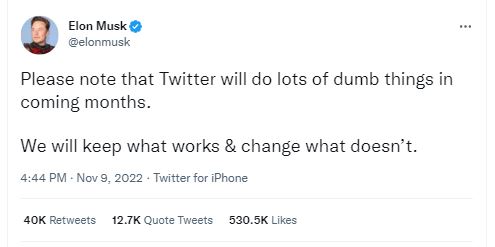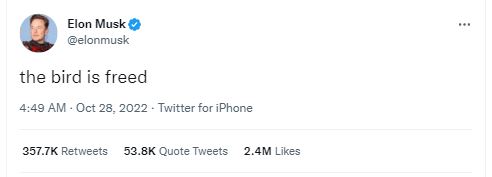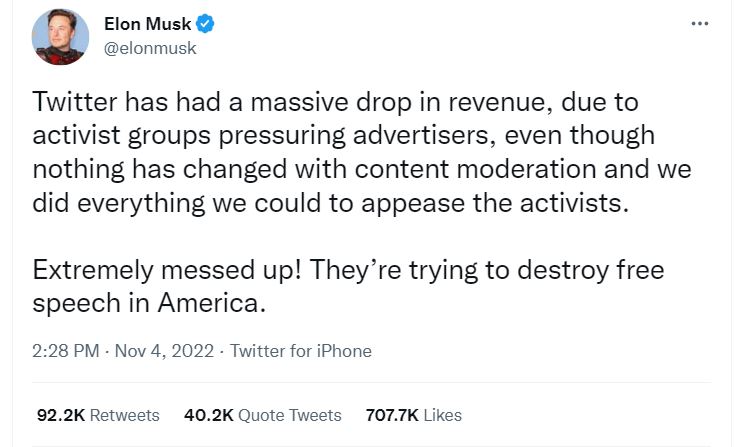So, what’s happening with Twitter? Elon Musk’s purchase of Twitter is hands down the biggest social media story of the year. The world’s richest man purchasing a waning social media giant; it would be the start of a modern day fairy tale if only there was less at stake. From debates on free speech to the role of tech in our society, the implications are both far spread and long lasting.
There’s been a lot of fast updates on this story, so you’d be forgiven for missing a tweet or two. Let’s catch you up on how we got to this point, what’s happening with Twitter now, and what the future might hold for the platform.
The Background
Elon Musk has been a vocal contributor on Twitter since he joined back in June of 2010. As a high profile individual he’s naturally acquired attention for many outspoken critiques of the platform’s operations. In particular, Twitter’s content moderation policies. Anyone remember Musk’s stance against the banning of Donald Trump? Over the years Musk has repeatedly claimed Twitter has failed to live up to its true potential, blaming both poor business acumen and PC culture. Easy arguments to make from behind a keyboard.
Musk’s criticisms really stole the spotlight once he began buying shares of the platform in January 2022. By April he became the company’s largest shareholder and was invited to join the company’s board of directors, which he declined. Just two weeks later on April 14th Musk made an unexpected and unsolicited bid to purchase the company for $44 billion, a grossly overvalued market price. That’s when the news really hit the proverbial fan.
A Change of Heart?
The bid drove plenty of discussion around Musk’s motivations for the purchase. Especially why such a successful business magnate would make such an obviously poor investment. Perhaps these criticisms got to Musk, as by July he shifted gears, threatening to pull out of the deal. Musk’s only public reasoning for this swift reversal was a claim that Twitter had misstated the number of bots on the platform. Naturally this damaged Twitter’s market value even further. The only issue here? The claim never held up.
Just days before Musk was to be taken to court over the pull-out he complied with the original deal. Elon Musk purchased Twitter on October 27th, setting in motion a series of events that will drastically impact the platform’s future.
Staffing Shakeups
To say Musk kicked down the front door is an understatement. On day one of the job Musk fired Twitter’s CEO Parag Agrawal, CFO Ned Segal, and head of legal policy, trust and safety Vijaya Gadde. With just a couple of days Musk has also dissolved the board of directors.
Then came the big cuts. By November 4th, Twitter had slashed nearly half their 7,500 staff in a massive round of layoffs. For those crunching numbers, this amounts to roughly 3,700 jobs lost in a single day. These roles range from foreign offices to the entire Ethical AI team.
There’s also been a series of high profile resignations within the last three weeks. These include chief information security officer Lea Kissner, chief privacy officer Damien Kieran and chief compliance officer Marianne Fogarty. We then saw the departures of Yoel Roth, the head of safety and integrity and Robin Wheeler, the head of client solutions. All major roles responsible for high level privacy designs and maintenance across the platform.
Changes to Policy and Culture
Needless to say, Musk has shaken up the workplace, inclusive of a mandatory return to office and cuts to staff lunches. It’s the changes to the platform itself however, that have caused the biggest stir.
Faithful to his initial gripes, Musk is focused on reducing censorship on the platform. He’s already walked back on the most extreme policy rollbacks in attempts to soothe advertisers concerns, but what rules will remain is unclear. Twitter is currently assembling a task force to discuss and implement new rules.
Then there’s the immediate cash play. Musk floated the idea of a paid account verification system. The initial $20 price tag was widely mocked online, before reducing down to a mere $8 a month. What could go wrong? More on that in a bit.
The Response
Let’s just say reaction has been swift.
Twitter has been accused of violating several worker protection laws in a class action lawsuit in the US. These acts, the federal Worker Adjustment and Retraining Notification Act (WARN) and California WARN Act, require companies to provide at least 60 days’ notice ahead of a mass firing.
The departure of high profile privacy officers has also attracted the attention of the Federal Trade Commission. The FTC had already been keeping close watch, having just reached a settlement with Twitter over privacy issues back in May.
Then there are US security officials, concerned about foreign influence on the platform. It doesn’t help that through Musk’s acquisition, a Saudi Prince, along with his estate, have become the second largest investors.
Twitter has also taken a big hit financially. Major advertisers have paused their campaigns, including General Motors, Pfizer, United Airlines, and General Mills, and more. These moves prompted a not so subtle response from Musk himself.
And that’s just from the higher profile parties. The public has had an entirely different field day with recent events.
Testing the Limits
Though no official policy has changed, it hasn’t stopped users across the pollical spectrum from testing its limits. Hate speech surged in the immediate days following the takeover, championed by those on the far right. Others pushed obviously false narratives such as the death of Donald Trump.
Then there’s the impersonation fiasco, originally led by pre-verified celebs like US comedian Kathy Griffin, who used her status to impersonate Musk himself. This issue was exacerbated once the pay-to-be-verified system launched, offering amusingly comical headaches for politicians and high profile companies all over the world. This led to a non-surprising pause on the program just days after launch.
For other perhaps less bold users, the idea of a great migration has trended across the platform. The largest benefactor of this change has been Mastodon, though discord channels have also been floated as an alternative. Thankfully for Twitter, while many users have created accounts on alternate sites we’ve yet to see a mass exodus on the platform itself. In fact, Twitter has seen spikes in daily active users since the acquisition, whether that’s due to a disaster porn phenomena or not.
If That’s What’s Happening with Twitter, What Comes Next?
So that’s a lot right? This story is very much live, with updates coming in seemingly by the minute.

What we do know is that the staff who remain have a massive task before them; make the platform profitable by luring back advertisers and users alike. On the policy side, we’ve yet to see what changes the new advisory board will come up with and whether it will attract and maintain active users. Finally there’s those pesky legal battles, which are sure to impact policy changes moving forward.
I don’t quite have the answers here. I don’t think Musk does either, but I do know I’ll be glued to the news with every update. Get out the popcorn, because there is plenty more to come.
What are your thoughts on what’s happening with Twitter?
Did you enjoy reading this blog post? If so, click here to read our previous blog post.












